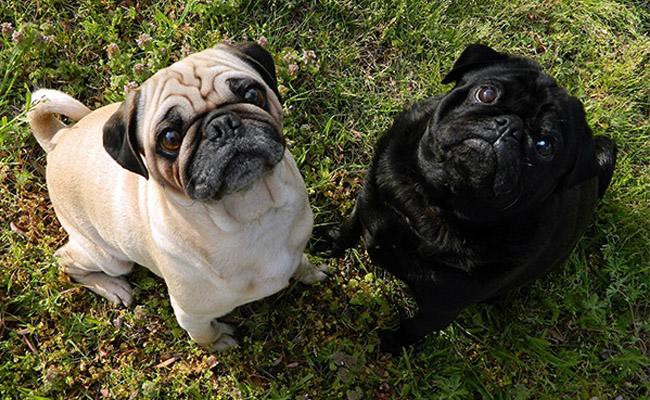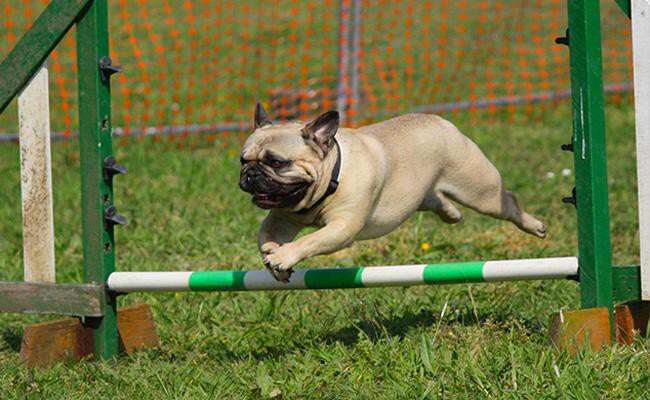Dog Pregnancy Calculator And Timeline
This social and extremely loyal dog breed, pugs have a very rich history; their existence dates back to even before 400 BCE when they were primarily called “lo-size” in China. Pugs were mostly kept as pets in Tibetan monasteries until they became famous as lapdogs and royal pets. Surprising but it’s a fact that this breed was mostly given royal treatment accompanied by the highest possible security in China. Lucky Pug he is, huh!
These dogs got their name from a monkey breed, Marmosets, that was initially called a pug; not just the name, they also share similar facial features.
Apart from being cuddly and all-so-set for pampering, they are prone to get glued to their masters and keep following them wherever they go, even if it is to the kitchen. They have also proven to be the best therapy dogs in nursing homes, hospitals and old-age homes.
If you are planning to buy a Pug for your kids to play with, then I suggest making acquaintance with the common features and behaviours associated with this dog breed.
Pug Breed Characteristics
- Origin: China
- Size: Small
- Dog Breed Group: Toy Group
- Purebred: Yes
- Lifespan: 13-15 Years
- Height: 10-13 inches (25-33 cm)
- Weight: 14-18 pounds (6-8 kg)
- Coat Appearance: Smooth, soft, and glossy
- Coat Colors: Fawn, black, apricot, silver
- Temperament: Charming, loving, mischievous, sociable, playful, calm
- Good With Children: Excellent with children
- Intelligence Level: Moderate
- Good With Pets: Yes, generally good with other dogs and pets
- Hypoallergenic: No
- Grooming: Moderate; requires regular cleaning of facial wrinkles
- Barking: Low; not prone to excessive barking
- Suitable For Apartments: Highly suitable for apartment living
- Need For Exercise: Moderate; needs daily walks but not overly strenuous activity
- Easy To Train: Yes, but can be stubborn; responds well to positive reinforcement
- Good For First Time Owners: Yes, very forgiving and good-natured for novice owners
- Health Issues: Brachycephalic syndrome, encephalitis, hip dysplasia, eye problems such as Pug Dog Encephalitis (PDE) and corneal ulcers, skin infections
- Litter Size: 4-6 puppies
- Average Price: $600 to $1,500 USD
Pug Size & Weight
Size – They are mostly 10 to 14 inches tall.
Weight – Both the female and male pugs weigh between 14 and 18 pounds.
A Pug usually gains weight as he grows old due to reduced metabolism so the quantity of food you give your dog must be limited if you want to keep your pet’s weight under control.
The other variety Teacup pugs are not actually recognized but they are small as claimed. The genetic defect of dwarfism is passed on to the next generation and the result is the still small miniature pug.
Pug Lifespan
This breed has a life span of 12 to 15 years, but a majority is known to survive up to a maximum of 13.8 years. But again, this factor largely depends on the health of the dog and also the extent of care that’s given to the dog.
Pug Temperament
The training offered to a Pug mostly decides the temperament of the pet. Good training would always result in gentle and calm behaviours from the pet and you can perhaps guess what an improper trainer can yield.
Mostly, the pugs are very friendly, loving and humorous; you can also expect them to be shy and introvert at times. Here’s a quick list of behaviours that the pug mostly exhibits;
- Docile – It is very rare to a find a pug behaving like an alpha; it is usually used to taking orders and never shows dislike towards someone commanding him.
- Sociable – Mostly all dogs are friendly and sociable but when it comes to a Pug, you will always notice that extra affection and friendliness.
- Playful – It goes without saying that the Pugs are extremely playful and can keep you entertained the whole day long.
- Stubborn – This might come as a surprise but it is so very true that Pugs can turn out to be stubborn at times. That doesn’t make them aggressive or demanding but their laziness can make them turn a deaf ear to orders. They love pleasing their masters so their stubbornness never lasts for long.
Pug Health Issues
Most of the flat-faced breeds suffer from skin issues, eye problems, and breathing issues.
Apart from the common health issues, they are also known to suffer from Pug Dog Encephalitis; this is an inflammatory disease that affects the nervous system and can sometimes turn out to be fatal.
Skin Cancer, mammary tumors and lymphoma are also very common in this breed. Pugs can easily grow obese if their weight is not kept under control.
Obesity in pugs can sometimes lead to major health problems like heart disease and may also affect the hips and the joints.
Loss of hearing, physically becoming very slow and sluggish is mostly due to the onset of aging. A proper diet is essential to help your pet live an active life.
Regular Checkup and vaccination are mandatory if you wish to see your pet running around happily. Choosing a proper vet is also vital; ensure you assign the best vet for the best health outcomes for your pet.
How To Train A Pug?
You may find housetraining your pug really difficult in the beginning because of their irregular potty habits. Prepare a schedule and stick to it; by the time your pet enters his 6th month, he will have learnt to take care of his needs by himself.
Ensure that the kennel you build for him has the required amount of space and facility to make him feel at ease in the first place. Gradually train him to take small orders and give him dog treats when he succeeds to fulfil a command.
Make sure you don’t fuss around him a lot for one single achievement; this might make him assume that he must take orders only when he is given treats; in fact, it should be the other way round.
Feeding A Pug
As discussed earlier, a Pug can literally grow obese if you don’t keep a check on his eating habits. Feeding the pug the right amount of right food and the right brand of food is very important to help it maintain a healthy weight and enjoy a healthy life. Here are a few tips on feeding a Pug;
- Choose top dog food brands or it would be best if you give home-cooked food.
- Schedule meal timings and stick to it; do not feed him extra. Splitting the meals into 3 – 4 intervals would be good.
- Consult a vet and give him vitamins or mineral supplement because normal food may not give him the required amount of nutrients.
- Avoid giving him unhealthy snacks and nuts. You could replace it with some branded dog treat or baby carrots.
Interesting Facts About A Pug
- A perfect Pug tail has 2 curls.
- The first breed is believed to have originated in Germany.
- In the 16th century, Prince William of Orange was known to have been saved by his pug from a terrible attack by oppositions.
- Owing to their extra short noses, they suffer from cold quite often.
- They sometimes sleep up to 14 hours a day. That’s too much!
Pug Names
| Male | Female |
|---|---|
| Ace | Sadie |
| Hank | Cookie |
| Oliver | Minnie |
| Charlie | Lady |
| Bo | Shelby |
| Rocco | Daisy |
| Brody | Piper |
| Buddy | Penny |
| Louie | Ella |
| Baxter | Millie |
What Are Girl Dog Names For Pugs?
- Ziggy
- Boo
- Mugsy
- Pugsly
- Loki
- Maddie
- Millie
- Roscoe
- Finn
- Jake
- Ella
- Moose
- Peaches
- Jasper
- Bugsy
- Bandit
- Pablo
- Buddha
- Ozzy
- Louis
- Bella
- Lola
- Lucy
- Daisy
- Lily
- Zoey
- Luna
- Stella
Pug Price
A standard lap-pug may cost you $250 but if you wish to own a well-trained pug like the ones that appear on shows, then it may cost you anywhere between $1500 -$2000.
The price of the dog depends on many factors such as the quality of the dog’s pedigree, the health test done by the breeder.
It’s quite difficult to judge the health and quality of a pug during the first 12 weeks. But you will gradually learn his temperament, medical requirements and feeding habits.
Pug Breeders
Here are a few tips for finding a reputable Pug breeder.
- Ensure that the breeder you choose is associated with either a national or local breed club.
- A good breeder will always interview the buyer before handing over the pet. The one who cares for his pups and ensures that it’s entrusted into the right hands is definitely a trustworthy breeder.
- You can always choose the breeders who assure to sign terms of sale papers and also guarantees you about the dog’s health.
- Some breeders may instruct you on the various ways to take care of your pet and train him while some may even give you written brochures. Stay away from the one who doesn’t give you enough information about the pup.
- Transfer of ownership paper is vital and the breeder should be willing to sign one.
Few breeders are so close to their pups that they would refuse to give them off if they don’t find your behaviour satisfactory. This is the actual sign of a good and reputable breeder.























